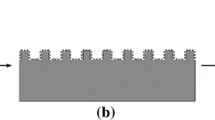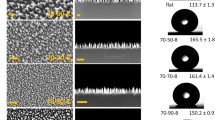Abstract
In recent years, hydrophobic surfaces have attracted more and more attentions from many researchers. In this paper, we comprehensively discussed the effects of specific parameters of microstructures on the wetting properties by using the theoretical models, the effects of microstructures on two-dimensional anisotropic properties and the water droplet impact experiment. Firstly, the relationships between the CAs and variable parameters were explored after the formula derivation for three various patterns. Then three different patterns were fabricated successfully on the silicon wafers by lithography technology and the effects of microstructures (including LWD parameters and interval parameters) on surface wettability were studied based on the theoretical research. After that, the effects of microstructures on two-dimensional anisotropic properties were also studied. Finally, the water droplet impact experiment was carried out and the viscoelastic properties were simply investigated. Our research proposed a potential method for fabricating hydrophobic surfaces with excellent anisotropic properties. This method may be widely used in a variety of academic and industrial applications in the future.







Similar content being viewed by others
References
Arifvianto B, Mahardika M, Dewo P (2011) Effect of surface mechanical attrition treatment (SMAT) on microhardness, surface roughness and wettability of AISI 316L. Mater Chem Phys 125:418–426
Barthlott W, Neinhuis C (1997) Purity of the sacred lotus, or escape from contamination in biological surfaces. Planta 202:1–8
Barthlott W, Schimmel T, Wiersch S et al (2010) The salvinia paradox: superhydrophobic surfaces with hydrophilic pins for air retention under water. Adv Mater 22:2325–2328
Bixler GD, Bhushan BF (2013) Fluid drag reduction and efficient self-cleaning with rice leaf and butterfly wing bioinspired surfaces. Nanoscale 5:7685–7710
Bizi-bandoki P, Valette S, Audouard E (2013) Time dependency of the hydrophilicity and hydrophobicity of metallic alloys subjected to femtosecond laser irradiations. Appl Surf Sci 273:399–407
Cai Y, Lin L, Xue Z et al (2014) Filefish inspired surface design for anisotropic underwater oleophobicity. Adv Funct Mater 24:809–816
Cassie A, Baxter S (1994) Wettability of porous surfaces. Trans Faraday Soc 40:546–551
Chen F, Zhang D, Yang Q (2010) Anisotropic wetting on microstrips surface fabricated by femtosecond laser. Langmuir 27:359–365
Doll K, Fadeeva E, Stumpp NS (2016) Reduced bacterial adhesion on titanium surfaces micro-structured by ultra-short pulsed laser ablation. BioNanoMaterials 17:1–2
Feng L, Li S, Li Y et al (2002) Super-hydrophobic surfaces: from natural to artificial. Adv Mater 14:1857–1860
Feng X, Gao Q, Wu X et al (2007) Superior water repellency of water strider legs with hierarchical structures: experiments and analysis. Langmuir 23:4892–4896
Gao XY, Guo ZG (2017) Biomimetic superhydrophobic surfaces with transition metals and their oxides: a review. J Bionic Eng 14:401–439
Gao X, Yan X, Yao X et al (2010) The dry-style antifogging properties of mosquito compound eyes and artificial analogues prepared by soft lithography. Adv Mater 19:2213–2217
He Y, Jiang CY, Yin HX (2011) Tailoring the wettability of patterned silicon sur-faces with dual-scale pillars: from hydrophilicity to superhydrophobicity. Appl Surf Sci 257:7689–7692
Kahng B, Jeong H, Barabasi AL (2001) Quantum dot and hole formation in sputter erosion. Appl Phys Lett 78:805–807
Kim T, Tahk D, Lee HH (2009) Wettability-Controllable super water- and moderately oil-repellent surface fabricated by wet chemical etching. Langmuir 25:6576–6579
Li H, Yu S, Han X (2016) A stable hierarchical superhydrophobic coating on pipeline steel surface with self-cleaning, anticorrosion, and anti-scaling properties. Colloid Surf A—Physicochem Eng Asp 503:43–52
Liu K, Du J, Wu J et al (2012) Superhydrophobic gecko feet with high adhesive forces towards water and their bio-inspired materials. Nanoscale 4:768–772
Vasilii B, Valentina M, Artem K et al (2018) Hydrophilic/hydrophobic surface modification impact on colloid lithography: schottky-like defects, dislocation, and ideal distribution. Appl Surf Sci 6:443–448
Wang G, Guo Z, Liu W (2014) Interfacial effects of superhydrophobic plant surfaces: a review. J Bionic Eng 11:325–345
Wenzel RN (1936) Resistance of solid surfaces to wetting by water. J Ind Eng Chem 28:988–994
Yang XM, Zhong ZW, Diallo EM et al (2014) Silicon wafer wettability and aging behaviors: impact on gold thin-film morphology. Math Sci Semicond Proc 26:25–32
Yong J, Yang Q, Chen F et al (2014) A simple way to achieve superhydrophobicity, controllable water adhesion, anisotropic sliding, and anisotropic wetting based on femtosecond-laser-induced line-patterned surfaces. J Mater Chem A 2:5499–5507
Young T (1805) An essay on the cohesion of fluids. Philos Trans R Soc A 95:65–87
Zhang G, Zhang J, Xie G et al (2006) Cicada wings: a stamp from nature for nanoimprint lithography. Small 2:1440–1443
Zhang X, Zhang J, Ren Z et al (2009) Morphology and wettability control of silicon cone arrays using colloidal lithography. Langmuir 25:7375–7382
Zhang D, Chen F, Yang Q et al (2011) Mutual wetting transition between isotropic and anisotropic on directional structures fabricated by femotosecond laser. Soft Matter 7:8337–8342
Zheng Y, Gao X, Jiang L et al (2007) Directional adhesion of superhydrophobic butterfly wings. Soft Matter 3:178–182
Zhu JJ, Tian YL, Yang CJ et al (2017a) Lithography-induced wettability Changes of Silicon. In: Shanghai: 2017 IEEE International Conference of Manipulation, Manufacturing and Measurement on the Nanoscale (3 M-NANO)
Zhu JJ, Tian YL, Yang CJ, Liu XP (2017b) Low-cost and fast fabrication of the ultrasonic embossing on polyethylene terephthalate (PET) films using laser processed molds. Microsyst Technol 23:5653–5668
Zhu JJ, Tian YL, Liu XP (2018) Rapid fabrication of super-hydrophobic surfaces of silicon wafers with excellent anisotropic wetting. Microsyst Technol 24:1–7
Acknowledgements
This work was supported by China-EU H2020 International Science and Technology Cooperation Project (FabSurfWAR Nos. 2016YFE0112100 and 644971) and National Natural Science Foundations of China [Nos. 51405333, 51675371, 51675376 and 51675367]. The authors are particularly grateful to Tianjin University and Xian Jiaotong University for the technical support. Jiajing Zhu wish to gratefully acknowledge the financial support by China Scholarship Council.
Author information
Authors and Affiliations
Corresponding author
Additional information
Publisher's Note
Springer Nature remains neutral with regard to jurisdictional claims in published maps and institutional affiliations.
Rights and permissions
About this article
Cite this article
Zhu, J., Tian, Y., Liu, X. et al. Lithography-induced hydrophobic surfaces of silicon wafers with excellent anisotropic wetting properties. Microsyst Technol 25, 735–745 (2019). https://doi.org/10.1007/s00542-018-4010-3
Received:
Accepted:
Published:
Issue Date:
DOI: https://doi.org/10.1007/s00542-018-4010-3




